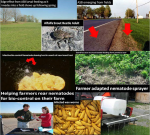 PERSISTENT BIOCONTROL NEMATODE PROTOCOLS DEVELOPMENT TIMELINE
PERSISTENT BIOCONTROL NEMATODE PROTOCOLS DEVELOPMENT TIMELINE
The use of persistent biocontrol nematodes native to northern New York State as a pest management solution begins with an invasive pest, a dairy farmer asking for help, and the commitment of his fellow farmers for finding a solution to alfalfa snout beetle. What no one anticipated was just how far pioneering the science to develop that solution would reach…
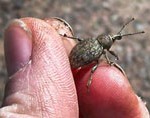
May 4, 1896: Alfalfa Snout Beetle (ASB) arrives in New York State
Alfalfa snout beetle (ASB) was first detected in New York State on May 4, 1896. ASB was introduced to the port of Oswego through shipping ballast from Europe. Once alfalfa was introduced as a forage crop, ASB would soon become the most destructive alfalfa crop pest wherever ASB was found.
The timeline that follows moves from the 2023 NNYADP persistent biocontrol project milestones back through time to the arrival of ASB in New York State. This chronicle traces the pioneering development – through laboratory and field trials on northern NY farms – of the science that would become a nature-based biocontrol not only for ASB but for other field crop and berry pests, and potentially vegetable and hops crops. All this was made possible by the long term commitment of the Northern New York Agricultural Development Program and the New York State Legislature… and the success story it is still being written today as field application and research trials continue throughout the U.S. with funding by other organizations and farmers themselves.
See additional information and resources links at the end of this timeline.
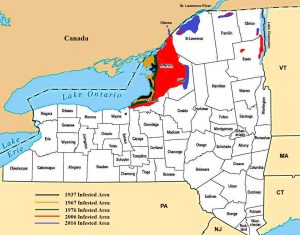
2023: An estimated 45,000 acres of farmland in northern NY have received persistent biocontrol nematodes for pest management.
In 2022, with funding from multiple sources and by farmers themselves, persistent biocontrol nematodes were applied in New York, Idaho, Illinois, Iowa, Nebraska, Wisconsin, and eastern Colorado, primarily for management of corn rootworm, but also as a trial for managing wireworm in hops crops.
2021: Breeding Alfalfa Cultivars with Higher Resistance to ASB
NNYADP Project Report: On-Farm Selection of Surviving Alfalfa Plants
August 2021: Biocontrol Nematodes Requested by NNY Potato Grower
A Northern New York/Franklin County potato grower requests a custom application of persistent biocontrol nematodes for wireworm management.
2020: Extension, Researchers, Growers in Other State Take Note of NNYADP Project Success
Texas A&M AgriLife Extension posted a “Results of Entomopathogenic Nematode Studies for Control of Corn Rootworm 2017-2019” video (20:51 min), produced by Texas A&M’s Patrick Porter and Ed Bynum, and Katelyn Kesheimer of Auburn University, Alabama, highlighting how the science of biocontrol nematode use developed in Northern New York was tested in 2017-2019 to help corn growers in Texas and New Mexico. This research began testing and proving the opportunity to apply the biocontrol nematodes by center pivot irrigation system.
2020 NNYADP Report: Evaluation of Alternative Application Methods of Biocontrol Nematodes in Alfalfa and Corn
2019: Biocontrol Nematodes Application Alternative
NNYADP Project Report: Biocontrol Nematodes Application Alternative: Mixed with Liquid Manure Applied to Corn and Alfalfa Fields – CCE Jefferson-initiated project
2019: Grow NY Finalist Establishes Persistent Biocontrol Nematodes Supply Enterprise
This new enterprise, a 2021 Grow NY competition finalist, is based in Austin, Texas.
2018: Three NNYADP Projects
NNYADP Project Report: Impact of Biocontrol Nematodes on Corn Rootworm During Corn Rotation: 2018
NNYADP Project Report: Evaluating Alternative Application Methods of Biocontrol Nematodes in Alfalfa and Corn
NNYADP Project Report: Breeding Alfalfa Varieties with Higher Resistance to ASB
2017: Impact on Corn Rootworm, Alfalfa Variety Resistance Breeding Progresses
NNYADP Project Report: Impact of Biocontrol Nematodes on Corn Rootworm During Corn Rotation: 2017 Trials
NNYADP Project Report: Breeding for Alfalfa Varieties with Resistance to Snout Beetle: 2017
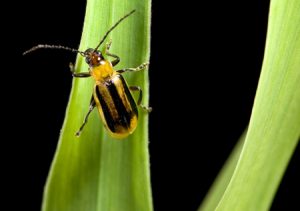
2016: Impact on Corn Rootworm Develops, Focus on Farmer Adoption
NNYADP Project Report: Impact of Biocontrol Nematodes on Corn Rootworm During Corn Rotation: 2016 Trials
NNYADP Project Report: Biological Control of Alfalfa Snout Beetle: Promoting New Farmer Adoption
The Shields Lab continues to offer farms interested in applying the biocontrol nematodes the option to purchase biocontrol nematodes or assistance with rearing their own nematodes on-farm with their own labor.
NNYADP Project Report: Breeding Alfalfa Varieties with Resistance to Alfalfa Snout Beetle: 2016
Cornell plant breeders continue efforts to increase the resistance levels to ASB larval root feeding so alfalfa stands have a measure of durability against significant beetle populations.
2016: Biocontrol Nematode Rearing Lab Established in NNY
Click here for a Spectrum TV story on how the research and technical assistance through the NNYADP-funded grants projects helped a young woman establish a new enterprise on her family farm in Moira, NY: https://spectrumlocalnews.com/north-country-blog/2016/12/16/research-helps-young-nny-ag-entrepreneur-build-new-business
2015: Extending Biological Control of ASB
A cost-sharing program for NNY farms to promote farmer adoption of the use of the persistent biocontrol nematodes was funded by a grant from the Northern New York Agricultural Development Program. This cost-sharing program was open to new and current participating producers, with preference given to producers with no previous nematode-treated fields. The program allowed interested new farms the opportunity to purchase the biocontrol nematodes at a 50% discount while returning farms received a 25% discount. The program also encouraged commercial applicators to participate by applying biocontrol nematodes as a possible addition to their business structure. To date, 77 farms have applied biological control nematodes on more than 250 fields covering 12,000-14,000 acres in six NNY counties.
NNYADP Project Report: Breeding ASB-Resistant Alfalfa Varieties
. . . Appendix A: Tables 1-2 with 1st and 2nd-year production results
• Extending Biological Control of ASB
2013-2014: Trials on a farm in northeastern NY showed the biocontrol nematodes effectively reduced populations of black vine weevil and strawberry root weevil (both closely related to ASB and difficult to control with conventional pesticides). The weevils had been causing as much as $30,000 in annual losses.

2012-2015: First ASB-Resistant Alfalfa Seed Commercially Available
An additional 85,000 seedlings were screened for ASB larval resistance in the greenhouse; promising plants intercrossed; and promising experimental lines tested in the field against ASB populations. Field trials planted using resistant varieties on farms near Adams, NY, and Lowville, NY, were evaluated through the first two years of production.
Alfalfa populations were selected for resistance to ASB for 7-9 cycles to determine differences in yield and root feeding damage. As a result, Seedway 9558 SBR was first made available to producers in 2013.
The Shields Lab at Cornell University makes a unique combination of two NY-native persistent nematodes available for application on grower fields to reduce ASB populations. Growers are now able to purchase ready-to-apply nematodes to their own fields, and ahave the option to purchase starter cups and rear their own nematodes to apply to their own fields.
Depending on the type of application method, the nematodes require 2-4 years for full effectiveness.
2008: First Field Trial of Alfalfa Varieties Bred for ASB-Resistance
After screening more than 150,000 seedlings for ASB resistance with the backcrossing of survivors, the first field trial to evaluate resistant varieties was planted in 2008 with encouraging results. Subsequent trials have been planted annually on ASB-infested land since 2008.
2004-2012: Developing Farmer-Friendly Biocontrol Nematode Protocols
Research focus becomes developing a “farmer-friendly” nematode rearing and application technique. Extension efforts were refocused on working with farmers and agribusiness consultants, teaching them the new techniques, and assisting them with nematode rearing and applications. The insect-attacking nematodes were applied/inoculated into more than 150 ASB-infested fields in northern New York’s 6 counties.
2002: The First Indication of Success
A farmwide population of ASB crash is recorded for the first time at the farm that initiated the research request. It became apparent that the entomopathogenic nematodes applied there had moved throughout the farm from test plots and were responsible for the ASB population crash.
1995-2002: Biological control efforts with entomopathogenic nematodes continued with field evaluations for persistence, development of application techniques using commercial sprayers, timing of application, and dose rates.
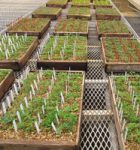
1996-1997: ASB-Resistant Plant Breeding Begins
A breeding program was initiated by Cornell University to develop potential alfalfa varieties that would be either more tolerant of or resistant to ASB feeding. This would require 10-20 years of intensive successive plant selection and breeding and field testing research.
1988-1989:Potential insecticides were evaluated as a stop-gap management option, but did not prove to be an effective management tool.
1976-1986: ASB Populations Explode in NY
ASB populations began to explode over a large area (9 NY counties). It was not uncommon for 2 million beetles per acre to exist. ASB can destroy entire fields of alfalfa in one growing season.
1939-1972: Chemical Treatments Banned
Populations of ASB were managed using poison baiting methods and heptachlor. In 1972, these methods were banned due to concern of environmental contamination.
1933: ASB was discovered as a pest in multiple fields in NY.

1920s: Alfalfa was introduced as a new forage crop for the dairy industry, and ASB became a significant pest almost immediately. It would increase to infest more than 500,000 acres in 9 NY counties.
May 4, 1896: Alfalfa Snout Beetle (ASB) arrives in New York State
Alfalfa snout beetle (ASB) was first detected in New York State on May 4, 1896. ASB was introduced to the port of Oswego through shipping ballast from Europe.
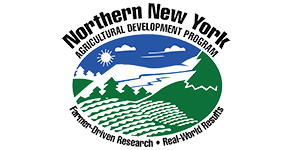 Funding for the Northern New York Agricultural Development Program is supported by the New York State Legislature through the New York State Assembly and administered by the New York State Department of Agriculture and Markets.
Funding for the Northern New York Agricultural Development Program is supported by the New York State Legislature through the New York State Assembly and administered by the New York State Department of Agriculture and Markets.
Click on the links below to learn more (2023):
Persistent Bicontrol Nematodes for Pest Management
Persistent Biocontrol Nematode Application Techniques
Persistent Biocontrol Nematodes: Instructional Manuals & Videos
Alfalfa Snout Beetle Life Cycle and Management
NNYADP Persistent Biocontrol Nematodes Year-to-Year Reports